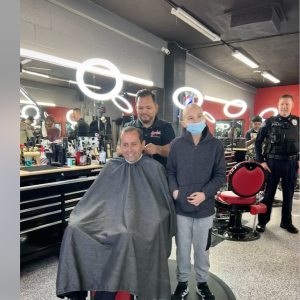 View Winners →
View Winners → Clairbourn School’s Robert W. Nafie Leaves a Lasting Legacy
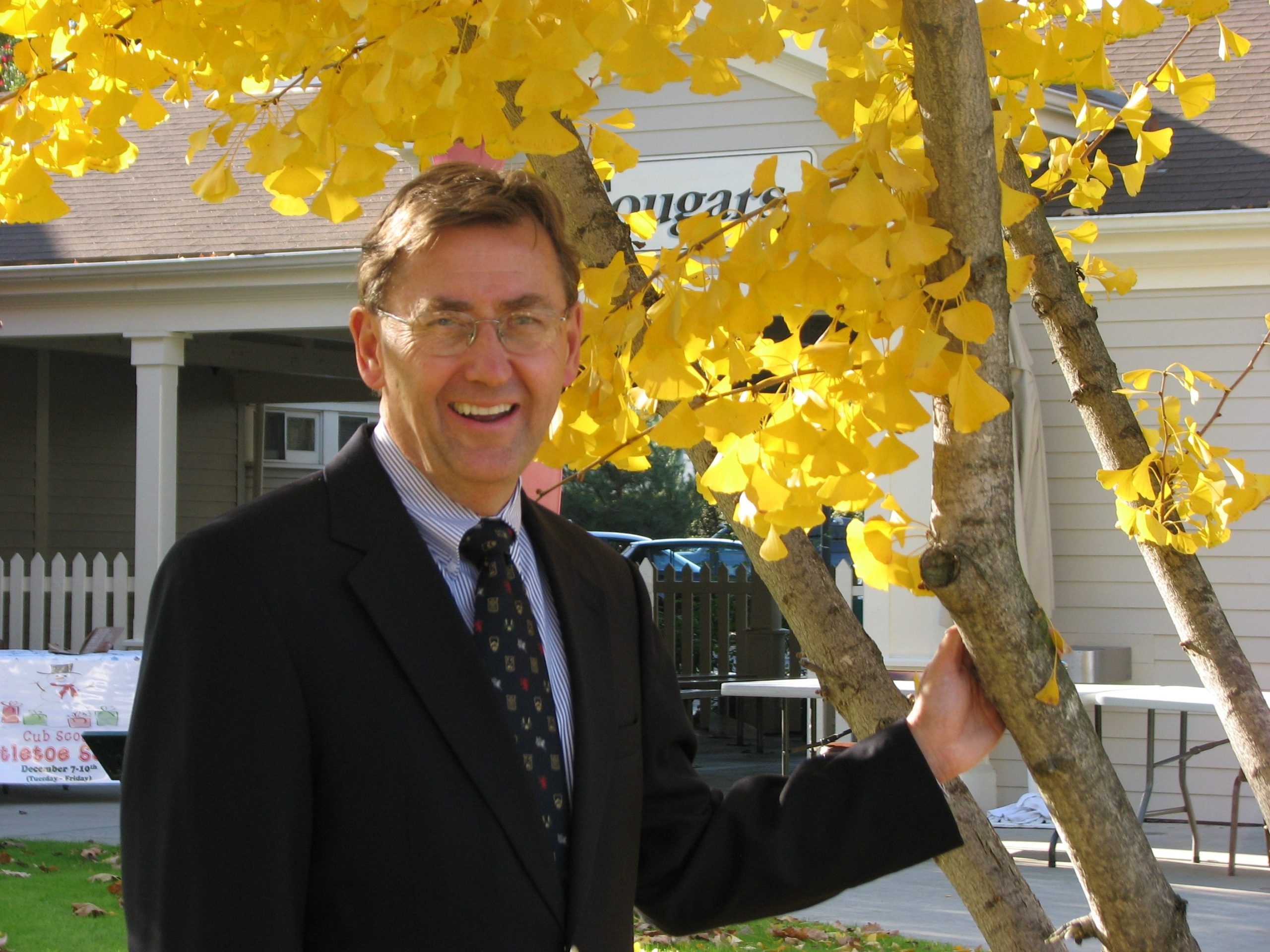
Dr. Robert Nafie dedicated 39 years of his life to Clairbourn School. – Courtesy photo
By May S. Ruiz
He’s at transportation every single day, rain or shine, opening car doors for students arriving in the morning and leaving in the afternoon. He’s the one constant for the thousands of children who have attended Clairbourn School through the decades – Dr. Robert W. Nafie, headmaster.
It was therefore with much melancholy that students and parents received his announcement that he was leaving at the end of the 2017-2018 school year. He’s such a permanent figure that it’s almost impossible to envision the school without his daily presence nor to imagine what Clairbourn was before he ever stepped foot on its campus.
The second of Edith and Marvin Nafie’s four boys, Robert William Nafie was born on September 7, 1948 in Detroit, Michigan, where he spent his earliest years. When he was nine years old, they moved to Farmington, a northwest suburb of Detroit. He remembers having a Huckleberry Finn childhood – running through the woods, building forts, swinging on ropes, and doing all manner of imaginative play.
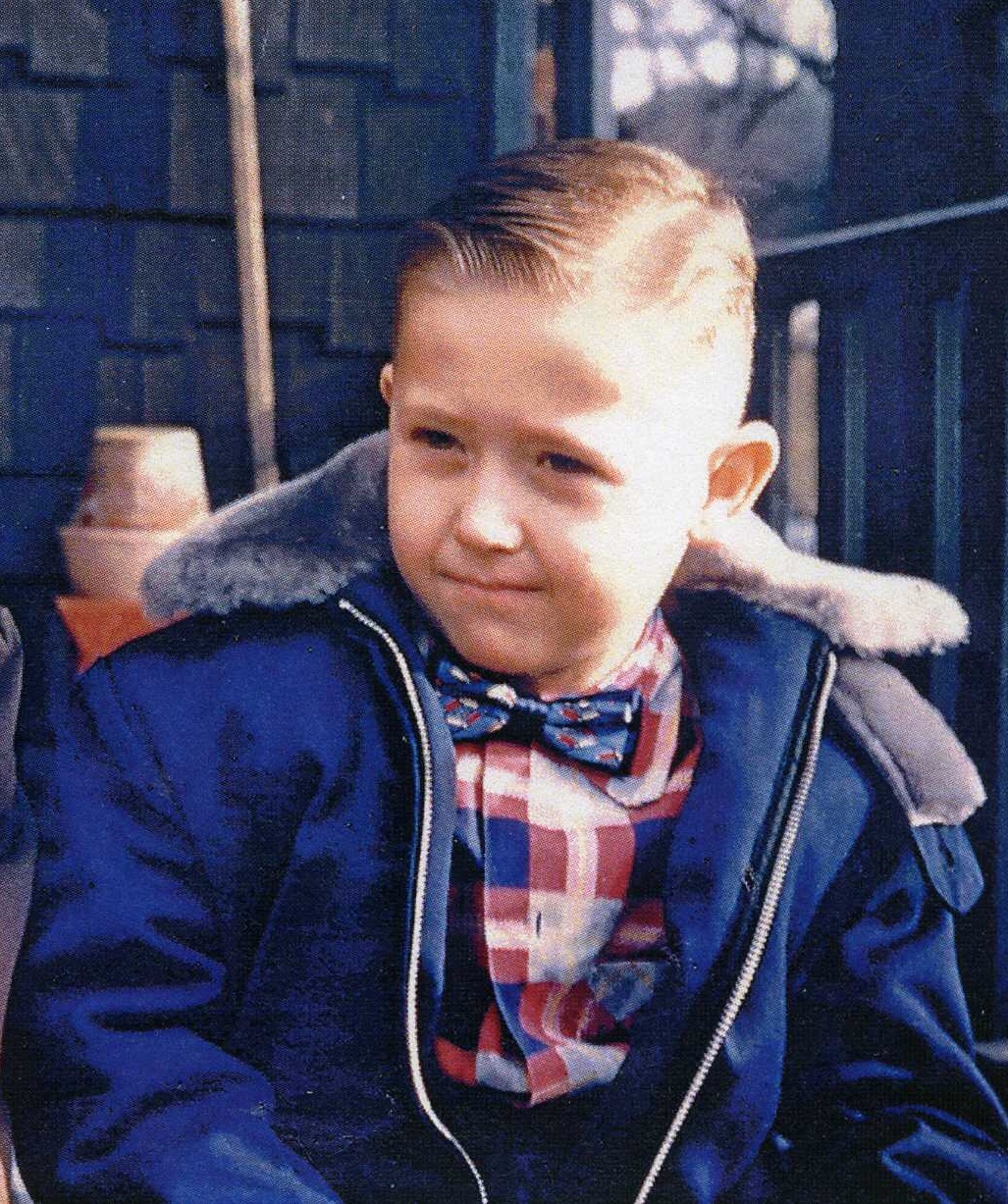
A portrait of five-year-old Robert William Nafie. – Courtesy photo / Nafie family.
When he was 12 years old his father, who worked at a firm that made parts used in different makes of cars, was offered the position of plant manager for a factory that was opening in Duluth, Minnesota.
He graduated from high school in Duluth and went to the local college affiliated with the University of Minnesota where he earned a four-year degree in History and Economics with a teaching certificate.
Directly after college he took a temporary post teaching U.S. history at the local junior high school which he once attended. After one-and-a-half years he found permanent employment at a special education school.
“Funding for special education became available in 1970 to establish community-based programs for young people who would otherwise have gone to state hospitals,” says Nafie. “It wasn’t what I had intended to do but I’ve always been humble and was taught to take advantage of opportunities that came my way.
“Within a year, the people I worked with and came in contact with felt there were much higher things in store for me and when a community-based facility needed a head, I was recommended and promptly hired.”
And so, at the age of 24, Nafie became the head of a community-based special education facility. Now he was running a school with 16 teachers all older than he in Eveleth, Minnesota, 60 miles north of Duluth.
It was there that he first demonstrated the nobility of purpose that would be the hallmark of his entire career. He states, “The facility was one that was no longer being used because the population had decreased. It was in such bad shape and looked like it was down on its luck; I didn’t want to put people who were already in dire straits in that building.”
He elaborates, “I had the audacity to write a grant for a program asking the state legislature for $500K to renovate the school. I was able to hire an architect who worked with me, from designing buildings to completion. This experience later proved useful during the construction years at Clairbourn. I earned a commendation from the governor of Minnesota for my efforts and the refurbished building opened to much fanfare attended by the governor.”
In 1974, he enrolled in a graduate program for educational administration at the University of Wisconsin at Superior, across from Duluth. Because of the distance of the drive, coupled with high gasoline prices, he rode a motorcycle 75 miles each way even in the bitter cold. He became the stuff of legend riding his little 250 Suzuki back and forth. He earned his Master’s degree in 1975; he was 27 years old.
Having gained state recognition, he came to the attention of the Developmental Learning Centers in Eveleth and became its executive director. He ultimately became the president of a statewide association of learning centers with headquarters on the eastern side of St. Paul, Minnesota. It had five locations, so he spent his time driving up and down the county overseeing building leases as well as supervising the instruction.
After being on the job for two years, Mr. Nafie decided he wanted to go back to general education and sent his resume to seven or eight schools. One of them was Clairbourn and, in August of 1979, he was invited to come to California to interview. “Who wouldn’t accept a plane ticket to California? Little did I know that it was over 100 degrees and they told me it wasn’t always like this,” he deadpans.
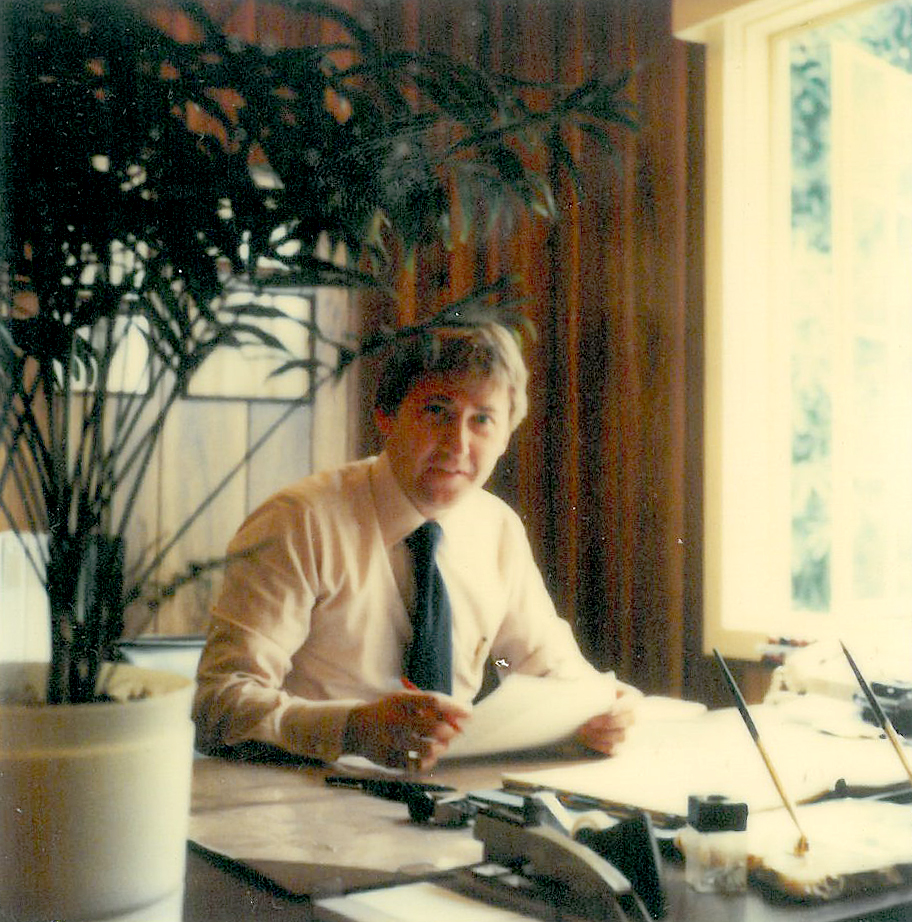
The 29-year-old headmaster. – Courtesy photo
The school needed a Development Director but it wasn’t what he wanted so he turned them down. However, the post of headmaster became vacant after the school year had begun and he was hired to fill it. And so in 1979, at the age of 29, he became headmaster of Clairbourn School. To make himself appear older he started wearing a suit to work every day, which became his trademark.
Jim Halferty, a Clairbourn alumnus and currently a real estate developer in Pasadena, was on the board back in 1979. He pronounces, “It was my best hire as a Clairbourn trustee. We interviewed several candidates, many of whom were much older and with more years of experience. But we decided we wanted someone young who would make his mark on the school. And Bob did just that; Clairbourn is what it is today because of him.”
When Nafie arrived at Clairbourn, the school was a disjointed grouping of structures on two different parcels of land, the grounds were uneven and unpaved, and the campus had no central area. His first course of action was to make the school a beautiful learning place for children.
“When I met with the board I told them my vision for educating children and how their environment affects learning. They all thought I rode in on a white horse and they were happy to give me every bit of the school along with all the problems that needed fixing. They threw it all at me, wished me well, and said they would call me in a few weeks. At least that’s how I saw it; but I was used to multi-tasking,” he smiles in recollection.
“I wanted it to be a school I could be proud to lead,” he declares. “I made the first ten years of my headship be about creating a master plan for restructuring the buildings and reconfiguring the campus. We hired an architect who worked with us on designing the classrooms and the grounds to look like a country day school. The architecture of the Manor House became the model for a unified appearance – all the structures would have the same Georgian Colonial style, with off-white walls and grey eaves. I also spearheaded a capital campaign to raise funds for the projects.”
During his first decade, he oversaw the creation of the new library, art studio, music room; new infrastructure – sidewalks, central lighting system, irrigation system, electrical and gas lines. He linked the two parcels by creating a campus center from which the students could get to either side of the school grounds upon arrival. Where there was once broken asphalt, a grassy central quad emerged, with walkways for children to use as they went to their classrooms. “The quad overlooked my office and I guarded it like a hawk; everyone knew not to step on the grass,” he quips.
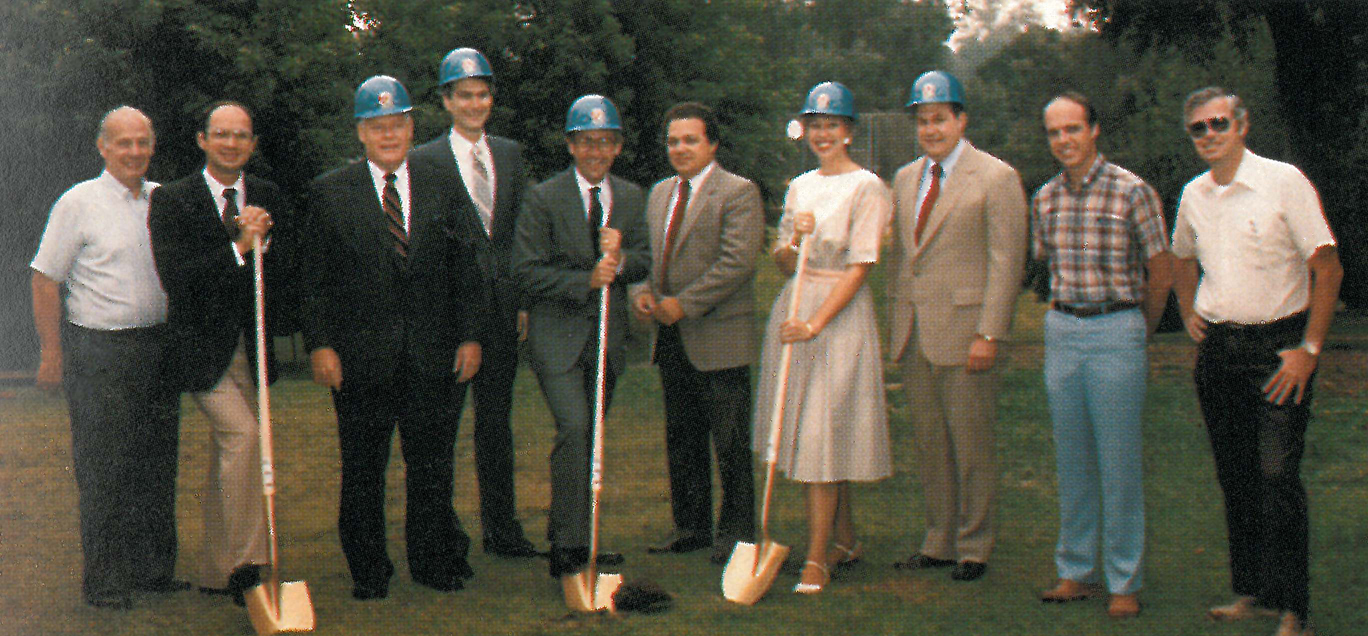
The first of many constructions that would span several years. – Courtesy photo
While all this was going on he attended the Claremont Graduate School and led the charge to demonstrate a strong model for teachers to follow. In 1983 he established what was called the Education Reimbursement Program which he himself took advantage of, from 1983 to 1985, when he earned his doctorate degree and henceforth became Dr. Nafie. When the program was first put in place, Clairbourn paid half the cost of a formal education for any teacher who desired to get a degree; today it covers 100% of tuition and books.
Towards the end of Dr. Nafie’s first decade, in 1987, he began thinking about a space where children could assemble for Chapel and meetings. The funds for this came from an unexpected source – a painting hanging in the Manor House which turned out to be ‘Pandora,’ an important work by Thomas Wilmer Dewing, which was sold at auction for $525K. And so the multi-purpose building (MPB) came about. For everyone who attends Clairbourn it is the hub of all activities, the heart of the campus.
The aesthetic and physical components of Clairbourn thus established, he concentrated on building the team to implement his vision for education. A restructuring of the administration was put into place for him to hire an Assistant Head of School, a Director of Business and Finance, a Director of Development, and an Admissions Director.
The vibrant parent community is what makes Clairbourn the beloved institution to which alumni and their parents keep coming back. The Clairbourn Families Association (CFA), which Dr. Nafie initiated, has a hand in every fund-raising activity the school undertakes. He expounds, “I wanted the parents to be involved in ways that didn’t touch on instruction, and the best way to accomplish that was to have them help out in the library. We developed a very strong link between the CFA and the library which persists today, and the Book Fair is a manifestation of this.”
Dr. Nafie adds, “Around that time we had an activity that was solely run by parents – the Cougar Corner. It was literally a small room in one corner that sold spirit items like pennants and sweatshirts. When we did all the construction, we moved it to a larger space across from the MPB and now it carries everything from soda and popcorn to neckties and gym bags.
The biggest and most extravagant CFA event, though, is the Spring Benefit and auction, an idea originated by parents. All these events gave parents the opportunity to be on campus, provide service, and add to student experience. The campus was more alive than ever before.”
“In 1989 the discussion was, ‘We had all these fine buildings but what are we going to do with them?’” Dr. Nafie remarks. “We wanted to ensure that our emphasis didn’t stop on structural concerns but would expand to our enrichment programs. So we launched a five-year Campaign for Excellence from 1990 to 1994 and called it ‘Building on a Promise.’ It also marked the second decade of my headship.”
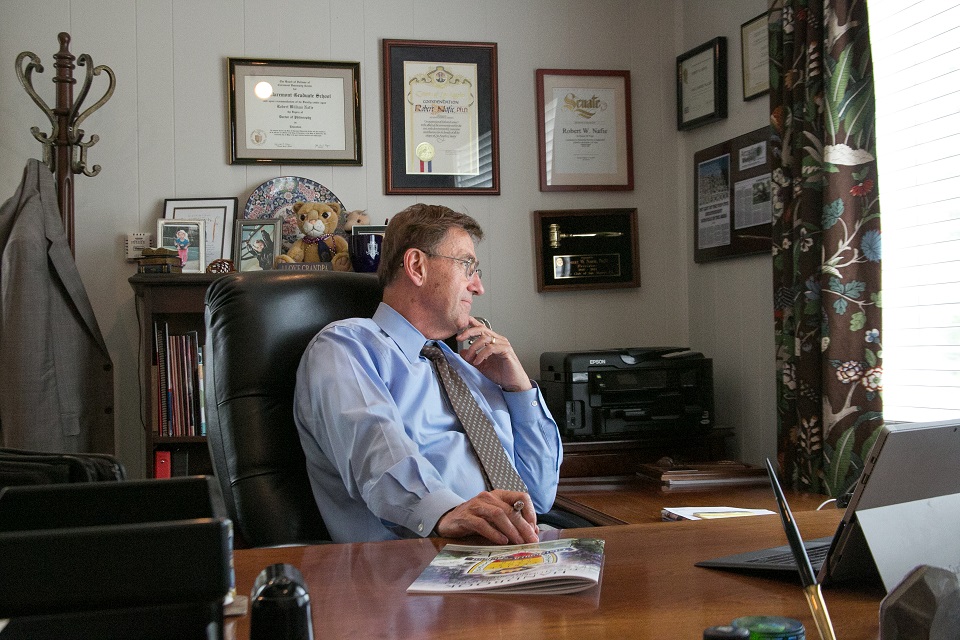
Dr. Nafie’s office overlooks the grassy quad. – Courtesy photo
As his third decade approached, Dr. Nafie focused once more on infrastructure, “We came up with a Master Plan to replace the Gardner building and reconfigure the entire area with a north/west orientation.” Randall Hall opened in 2001 with state-of-the-art synthetic surface play yard.
“In 2002, Master Plan Phase 2 construction began on Andrew Hall which included the Transportation Pavilion. Completed in January of 2003, this formed a covered space for children and an orderly place for them to wait for their rides.
This was closely followed by the razing of the existing nursery building, and in its place the Seiter Center was erected and opened in 2008.”
It was also in this decade that he inaugurated a program distinct to the Clairbourn experience. Beginning in 2000, Clairbourn exchanged students with host families from the Huntingtower School in Melbourne, Australia. A highlight of the middle school experience, this not only established bonds among students but adults as well. To this day those relationships continue as former parents visit Melbourne and are hosted by Huntingtower teachers in their homes, and vice-versa.
The 2008 recession and its aftermath marked Dr. Nafie’s fourth decade. This necessitated a restructuring of jobs and consolidation of roles among the administration and staff. At the same time, the population of the area changed with the influx of Asian families and they came to Clairbourn with different education needs and expectations.
Clairbourn focused on STEM and designed a curriculum to reflect this. It was also at this time that Clairbourn’s business systems and functions moved online and the school’s print publications adopted a digital platform.
Dr. Nafie’s tenure wasn’t all about construction and structural face-lifts but also about upholding the essence that would define his 39-year stewardship – a dynamic engagement with his students and parents.
An annual tradition that he started in 1981 is singing a song for moms during Mothers’ Visiting Day’s morning assembly. He recalls, “I wanted to make myself more approachable to the students; to be more human for them to get to know me personally and, hopefully, for them to know that I care about them. So I speak with them every day at Chapel and I play the guitar and sing for them annually.”
For years, at the Spring Carnival, Dr. Nafie would gamely sit in the dunk tank and students all fought for the honor of throwing a baseball to trigger the button that would collapse the plank he was perched on, dunking him in a tank of water. This always got everyone laughing and he would join in the hilarity as he came out, dripping wet in his suit.
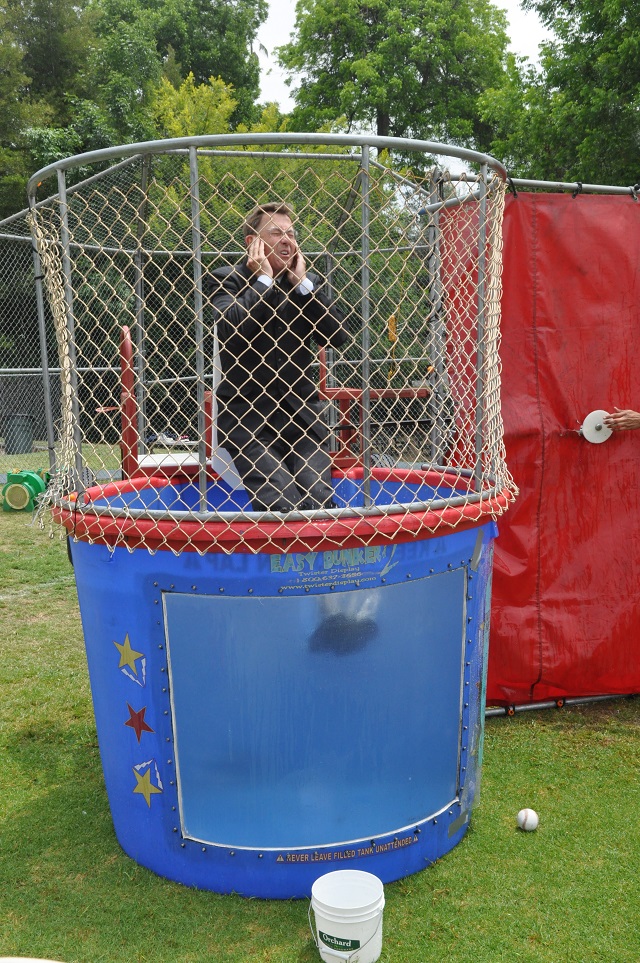
Dr. Nafie in the dunk tank during the Spring Carnival. – Courtesy photo
“The carnival was already in place when I arrived but I wasn’t in the dunk tank yet. That was another parent idea, now that I think about it. They quickly identified me as someone who would do almost anything,” he chuckles in reminiscence.
Throughout his four decades at Clairbourn, Dr. Nafie exhibited the many dimensions that make him a uniquely fascinating man. He is as wise as he is witty, with as much affinity for badinage as for waxing philosophical. He is as charming in his self-deprecation as he is stubborn in his opinions. He is at once a student acquiring a vast wealth of information and a teacher imparting his knowledge and homespun wisdom. He is well-read and well-traveled, with a wide range of hobbies and interests. An avid ornithologist, he spouts all kinds of bird trivia. An aviator, he relates in awe the sublime feeling of soaring over the horizon and marveling at the splendor that is God’s making.
When he starts his day drinking a cup of coffee, Dr. Nafie reads the L.A. Times, The (London) Times, and the Wall Street Journal. Some bits of information he gleaned would often find their way to morning Chapel to inform students and parents of what’s happening here or abroad and how these relate to them or to that day’s teaching.
Or, he would recount that when he went to get a cheeseburger, fries, and a coke at In-N-Out the previous evening, he reached the pick-up window only to realize that he hadn’t ordered. There’s a lesson in there somewhere, but they forget. What they do remember is that they recognize themselves in his moments of humanity.

Dr. Nafie will continue to be involved with Clairbourn School as a trustee. – Courtesy photo / Anne Boughton (Nafie’s daughter)
By allowing the Clairbourn community into his personal life, he inadvertently let them have some ownership of it. That’s why when he was diagnosed with cancer last year and underwent chemotherapy and stem cell transplant, they rallied as one to support him. They were there through his illness and treatment. They fought it with him and would have fought it for him, if it came down to that. Happily, he is now in full recovery for they would have rejected any other outcome.
When asked what he considers his biggest accomplishment and what he sees in the school’s future, he replies, “I’m most proud of developing the Clairbourn campus into one of the most elite school campuses in the area – with its many facilities up-to-date and all paid for. Ten years hence, it will have a consistently superior faculty with complementary facilities in a multi-culturally diverse community that loves its school and cherishes its legacy.”
Dr. Nafie transformed the Clairbourn campus into one that inspires reflective erudition and meaningful discourse. He has made it his life’s work to create a school that provides both a challenging and nurturing environment. For 39 years he led his students, parents, faculty, and staff to become educated, well-informed, caring members of society.
Clairbourn stands today as a magnificent realization of his vision – the embodiment of an excellent education based on a code of ethics of honesty, respect, responsibility, spirituality, and citizenship. It’s a school that Dr. Nafie can not only be truly honored to have led but that which its community is proud of. He leaves a beautiful legacy, which he will continue to cultivate as a trustee, to ensure that it does more than endure but flourish for decades yet to come.



























































